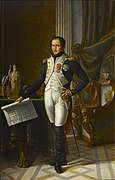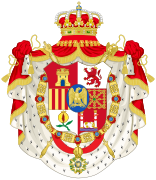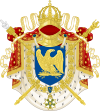Joseph Bonaparte
This article includes a list of general references, but it lacks sufficient corresponding inline citations. (June 2011) |
| Joseph I | |||||
|---|---|---|---|---|---|
 Portrait by Joseph Flaugier, c. 1809 | |||||
| King of Spain and the Indies | |||||
| Reign | 6 June 1808 – 11 December 1813 | ||||
| Predecessor | Ferdinand VII | ||||
| Successor | Ferdinand VII | ||||
| King of Naples and Sicily | |||||
| Reign | 30 March 1806 – 6 June 1808 | ||||
| Predecessor | Ferdinand IV | ||||
| Successor | Joachim I | ||||
| Born | 7 January 1768 Corte, Corsica | ||||
| Died | 28 July 1844 (aged 76) Florence, Tuscany | ||||
| Spouse | Julie Clary | ||||
| Issue | Zénaïde Laetitia Julie Bonaparte Charlotte Napoléone Bonaparte | ||||
| |||||
| House | Bonaparte | ||||
| Father | Carlo Buonaparte | ||||
| Mother | Letizia Ramolino | ||||
| Religion | Roman Catholicism | ||||
Joseph-Napoléon Bonaparte (born Giuseppe Buonaparte; 7 January 1768 – 28 July 1844) was a French diplomat and nobleman, the elder brother of Napoleon Bonaparte, who made him King of Naples and Sicily (1806–1808), and later King of Spain (1808–1813, as José I). After the fall of Napoleon, Joseph styled himself Comte de Survilliers.
Early years and personal life
Joseph was born in 1768 to Carlo Buonaparte and Maria Letizia Ramolino at Corte, the capital of the Corsican Republic. In the year of his birth, Corsica was invaded by France and conquered the following year. His father was originally a follower of the Corsican Patriot leader, Pasquale Paoli, but later became a supporter of French rule.
As a lawyer, politician, and diplomat, Joseph served in the Cinq-Cents and was the French ambassador to Rome. On 30 September 1800, as Minister Plenipotentiary, he signed a treaty of friendship and commerce between France and the United States at Morfontaine, alongside Charles Pierre Claret de Fleurieu, and Pierre Louis Roederer.
He married Marie Julie Clary daughter of François Clary on 1 August 1794 in Cuges-les-Pins, France. They had three daughters:
- Julie Joséphine Bonaparte (29 February 1796 - 6 June 1797).
- Zénaïde Laetitia Julie Bonaparte (8 July 1801 – 1854); married, in 1822 to Charles Lucien Bonaparte.
- Charlotte Napoléone Bonaparte (31 October 1802 – 2 March 1839); married, in 1826 to Napoleon Louis Bonaparte.
He claimed the two surviving daughters as his heirs. He also sired two children with Maria Giulia, the Countess of Atri:
- Giulio (1806– )
- Teresa (1808– ).
Joseph had two American daughters born at Point Breeze, his estate in Bordentown, New Jersey, by his mistress, Annette Savage ("Madame de la Folie"):
- Pauline Anne; died young.
- Catherine Charlotte (1822–1890); married Col. Zebulon Howell Benton of Jefferson County, New York, and had issue:[1] Louis Joseph Benton (1848-1940) and son Frederick Joseph Benton (1901-1967)[2]
In 1795 Joseph was a member of the Council of Ancients, where he used his position to help his brother overthrow the Directory four years later.
The Château de Villandry had been seized by the French Revolutionary government; and, in the early 19th century, Joseph's brother, Emperor Napoleon, acquired the château for him. In 1806, Joseph was given military command of Naples, and shortly afterward was made king by Napoleon, to be replaced two years later by his sister's husband, Joachim Murat. Joseph was then made King of Spain in August 1808, soon after the French invasion.
Spain


Joseph somewhat reluctantly left Naples, where he was popular, and arrived in Spain where he was very unpopular indeed. Joseph came under heavy fire from his opponents in Spain, who tried to smear his reputation by calling him Pepe Botella (Joe Bottle) for his alleged heavy drinking, an accusation echoed by later Spanish historiography, despite the fact that Joseph was abstemious. His arrival sparked the legitimate Spanish revolt against French rule, and the beginning of the Peninsular War. Thompson says the Spanish revolt was, "a reaction against new institutions and ideas, a movement for loyalty to the old order: to the hereditary crown of the Most Catholic kings, which Napoleon, an excommunicated enemy of the Pope, had put on the head of a Frenchman; to the Catholic Church persecuted by republicans who had desecrated churches, murdered priests, and enforced a "loi des cultes"; and to local and provincial rights and privileges threatened by an efficiently centralized government.[3]
Joseph temporarily retreated with much of the French Army to northern Spain. Feeling himself in an ignominious position, Joseph then proposed his own abdication from the Spanish throne, hoping that Napoleon would sanction his return to the Neapolitan Throne he had formerly occupied. Napoleon dismissed Joseph's misgivings out of hand; and, to back up the raw and ill-trained levies he had initially allocated to Spain—the Emperor sent heavy French reinforcements to assist Joseph in maintaining his position as King of Spain. Despite the easy recapture of Madrid, and nominal control by Joseph's government over many cities and provinces, Joseph's reign over Spain was always tenuous at best, and constantly resisted by pro-Bourbon guerrillas. Joseph and his supporters never established complete control over the country.
King Joseph's Spanish supporters were called josefinos or afrancesados (frenchified). During his reign, he ended the Spanish Inquisition, partly because Napoleon was at odds with Pope Pius VII at the time. Despite such efforts to win popularity, Joseph's foreign birth and support, plus his membership in a Masonic lodge,[4] virtually guaranteed he would never be accepted as legitimate by the bulk of the Spanish people. During Joseph's rule of Spain, Venezuela declared independence (1810) from Spain, the first nation to do so. The king had virtually no influence over the course of the ongoing Peninsular War: Joseph's nominal command of French forces in Spain was mostly illusory, as the French commanders theoretically subordinate to King Joseph insisted on checking with Napoleon before carrying out Joseph's instructions.
King Joseph abdicated and returned to France after the main French forces were defeated by a British-led coalition at the Battle of Vitoria in 1813. He was seen by Bonapartists as the rightful Emperor of the French after the death of Napoleon's own son Napoleon II in 1832, although he did little to advance his claim.
United States
Joseph lived primarily in the United States (where he sold the jewels he had taken from Spain) in the period 1817–1832,[5] initially in New York City and Philadelphia, where his house became the centre of activity for French expatriates, but later moved to an estate, formerly owned by Stephen Sayre, called Point Breeze in Bordentown, New Jersey. Joseph's home was located near the confluence of Crosswicks Creek and the Delaware River. He considerably expanded Sayre's home and created extensive gardens in the picturesque style. When his first home was destroyed by fire in January 1820 he converted his stables into a second grand house. At Point Breeze, Joseph entertained many of the leading intellectuals and politicians of his day.
Reputedly some Mexican revolutionaries offered to crown him Emperor of Mexico in 1820, but he declined.[5]
Joseph Bonaparte returned to Europe, where he died in Florence, Italy, and was buried in the Les Invalides building complex in Paris.[6]
Freemasonry
Joseph Bonaparte was admitted in Marseille's lodge la Parfaite Sincérité in 1793.[7][8][9] He was asked by his brother Napoleon to monitor freemasonry as Grand Master of the Grand Orient of France (1804–1815).[10][11][12][13] With Cambacérès he managed the post-revolution rebirth of the Order in France.[10][14][15][16]
Gallery
-
Portrait by Jean-Baptiste Wicar, 1808
-
Coat of arms as King of Naples
-
Coat of arms as King of Spain
-
Royal Monogram as King of Spain
-
Spanish gold coin from 1811
Titles and styles
- 7 January 1768 – circa 1795: Nobile Giuseppe Buonaparte
- circa 1795 – 1804: Joseph Bonaparte
- 1804 – 30 March 1806: French Prince Joseph-Napoleon, The Grand Elector
- 30 March 1806 – 6 June 1808: His Majesty By the Grace of God and the Constitution of the State, King of Naples.
- 6 June 1808 – 11 December 1813: His Majesty By the Grace of God, King of Spain and the Indies.
- 1815–1833 (styled, not officially) Count of Survilliers
Legacy
- Joseph Bonaparte Gulf in the Northern Territory of Australia is named after him.
- Lake Bonaparte, located in the town of Diana, New York, United States, is also named after him.
- A main character in Golden Boy by Clifford Odets is named Joe Bonaparte after him.
Fictional portrayals
The romantic web between Joseph Bonaparte, Napoleon, Jean-Baptiste Bernadotte, Julie Clary and Désirée Clary was the subject of the 1951 novel Désirée, by Annemarie Selinko.
The novel was filmed as Désirée in 1954, with Marlon Brando as Napoleon, Jean Simmons as Désirée, and Cameron Mitchell as Joseph Bonaparte.
Ancestry
| Family of Joseph Bonaparte | ||||||||||||||||||||||||||||||||||||||||||||||||||||||||||||||||||||||||||||||||||||||||||||||||||||||||||||||||||||||||||||||||||||||||||||||||||||||||||||||||||||||||||||||||||||||||||||||||||||||||||||||||||||||||||||||||||||||||||||||||||||||||||||||||||||||||||||||||||||||||||||||||||||||||||||||||||||||||||||||||||||||||||||||||||||||||||||||||||||||||||||||||||||||||||||||||||||||||||||||||||||||||||||||||||||||||||||||||||||||||||||||||||||||||||||||||||||||||||||||||||||||||||||||||||||||||||||||||||||||||||||||||||||||||||||||||||||||||||||||||||||||||||||||||
|---|---|---|---|---|---|---|---|---|---|---|---|---|---|---|---|---|---|---|---|---|---|---|---|---|---|---|---|---|---|---|---|---|---|---|---|---|---|---|---|---|---|---|---|---|---|---|---|---|---|---|---|---|---|---|---|---|---|---|---|---|---|---|---|---|---|---|---|---|---|---|---|---|---|---|---|---|---|---|---|---|---|---|---|---|---|---|---|---|---|---|---|---|---|---|---|---|---|---|---|---|---|---|---|---|---|---|---|---|---|---|---|---|---|---|---|---|---|---|---|---|---|---|---|---|---|---|---|---|---|---|---|---|---|---|---|---|---|---|---|---|---|---|---|---|---|---|---|---|---|---|---|---|---|---|---|---|---|---|---|---|---|---|---|---|---|---|---|---|---|---|---|---|---|---|---|---|---|---|---|---|---|---|---|---|---|---|---|---|---|---|---|---|---|---|---|---|---|---|---|---|---|---|---|---|---|---|---|---|---|---|---|---|---|---|---|---|---|---|---|---|---|---|---|---|---|---|---|---|---|---|---|---|---|---|---|---|---|---|---|---|---|---|---|---|---|---|---|---|---|---|---|---|---|---|---|---|---|---|---|---|---|---|---|---|---|---|---|---|---|---|---|---|---|---|---|---|---|---|---|---|---|---|---|---|---|---|---|---|---|---|---|---|---|---|---|---|---|---|---|---|---|---|---|---|---|---|---|---|---|---|---|---|---|---|---|---|---|---|---|---|---|---|---|---|---|---|---|---|---|---|---|---|---|---|---|---|---|---|---|---|---|---|---|---|---|---|---|---|---|---|---|---|---|---|---|---|---|---|---|---|---|---|---|---|---|---|---|---|---|---|---|---|---|---|---|---|---|---|---|---|---|---|---|---|---|---|---|---|---|---|---|---|---|---|---|---|---|---|---|---|---|---|---|---|---|---|---|---|---|---|---|---|---|---|---|---|---|---|---|---|---|---|---|---|---|---|---|---|---|---|---|---|---|---|---|---|---|---|---|---|---|---|---|---|---|---|---|---|---|---|---|---|---|---|---|---|---|---|---|---|---|---|---|---|---|---|---|---|---|---|---|---|---|---|---|---|---|---|---|---|---|---|---|---|---|---|---|---|---|---|---|---|---|---|---|---|---|---|---|---|---|---|---|---|---|---|---|---|---|---|---|---|---|---|---|---|---|---|---|---|---|---|---|---|---|---|---|---|---|---|---|---|---|---|---|---|---|---|---|---|---|---|---|---|---|---|---|---|---|---|---|---|---|---|---|---|---|---|---|---|---|---|---|---|---|---|---|---|---|---|---|---|---|---|---|---|
| ||||||||||||||||||||||||||||||||||||||||||||||||||||||||||||||||||||||||||||||||||||||||||||||||||||||||||||||||||||||||||||||||||||||||||||||||||||||||||||||||||||||||||||||||||||||||||||||||||||||||||||||||||||||||||||||||||||||||||||||||||||||||||||||||||||||||||||||||||||||||||||||||||||||||||||||||||||||||||||||||||||||||||||||||||||||||||||||||||||||||||||||||||||||||||||||||||||||||||||||||||||||||||||||||||||||||||||||||||||||||||||||||||||||||||||||||||||||||||||||||||||||||||||||||||||||||||||||||||||||||||||||||||||||||||||||||||||||||||||||||||||||||||||||||
See also
References
- ^ The Growth of a Century: as Illustrated in the History of Jefferson County
- ^ 1880 and 1910 US CENSUS Pennsylvania population via Ancestry.com
- ^ J. M. Thompson, Napoleon Bonaparte: His Rise and Fall (1951) 244-45
- ^ Ross, Michael The Reluctant King, 1977, pp. 34–35
- ^ a b "Joseph Bonaparte at Point Breeze". Flat Rock. Retrieved 8 July 2011.
- ^ Kwoh, Leslie (10 June 2007). "Yes, a Bonaparte feasted here". Star Ledger. Retrieved 19 February 2008.
- ^ La franc-maçonnerie Jean Massicot (Desnoël ed.)
- ^ Les Francs-maçons et leur religion Jacques Duchenne (Publibook ed.)
- ^ Revue d'histoire de Bayonne, du pays basque et du Bas-Adour, Numéro 159, page 176
- ^ a b Franc-maçonnerie et politique au siècle des lumières: Europe-Amérique page 55 – article Le binôme franc-maçonnerie-Révolution – José Ferrer Benimeli (Presses Univ de Bordeaux ed., 2006)
- ^ Histoire de la franc-maçonnerie en France Jean André Faucher and Achille Ricker (Nouvelles éditions latines ed., 1967)
- ^ Histoire du Grand Orient de France page 338, Achille Godefroy Jouaust, (Brissard et Teissier ed. 1865)
- ^ Chronique de la Franc-maçonnerie en Corse: 1772-1920 page 66 - Charles Santoni ( A. Piazzola ed., 1999)
- ^ Les francs-maçons: Des inconditionnels de l'espoir page 22 François Deschatres (L’Harmattan ed. 2012)
- ^ Histoire de la franc-maçonnerie en France – page 231 Jean André Faucher and Achille Ricker
- ^ Essai sur l'origine et l'histoire de la franc-maçonnerie en Guadeloupe - Guy Monduc (G. Monduc ed., 1985)
Further reading
- Schom, Alan (1997). Napoleon Bonaparte: A Life. New York: Harper Collins. ISBN 9780060929589.
- Stroud, Patricia Tyson (2005). The Man who had been King: The American Exile of Napoleon's Brother Joseph. Philadelphia, PA: University of Pennsylvania Press. ISBN 9780812290424. biography: book received the New Jersey Council for the Humanities first place book award in 2006.
External links
- Use dmy dates from August 2012
- 1768 births
- 1844 deaths
- People from Bordentown, New Jersey
- People from Corte, Haute-Corse
- Spanish monarchs
- Monarchs of Naples
- House of Bonaparte
- French people of Italian descent
- Knights of Santiago
- Knights of the Golden Fleece
- Members of the Council of Five Hundred
- Members of the Sénat conservateur
- Members of the Chamber of Peers of the Hundred Days
- French Roman Catholics
- Grand Croix of the Légion d'honneur
- Grand Masters of the Order of the Golden Fleece
- Monarchs who abdicated
- Grand Crosses of the Royal Order of Spain
- Heirs presumptive to the French throne
- People of the Peninsular War
- 19th-century monarchs in Europe
- French Freemasons









